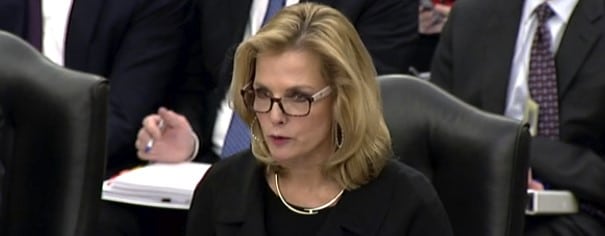
WASHINGTON — The National Nuclear Security Administration (NNSA) will decide in early May whether it wants to build nuclear-warhead cores known as plutonium pits at the Savannah River Site in Aiken, S.C., the agency’s new administrator said here Wednesday in congressional testimony.
The Pentagon needs the NNSA by 2030 to produce 80 plutonium pits a year to refurbish aging U.S. nuclear warheads. The Los Alamos National Laboratory in New Mexico is building new facilities intended to crank out 30 pits annually by 2026, but the NNSA is weighing whether the remaining 50 could be made at Savannah River.
In testimony before the Senate Armed Services strategic forces subcommittee, NNSA Administrator Lisa Gordon-Hagerty told lawmakers the results — in draft form, anyway — are in from the engineering analysis the agency will use to decide whether a pit move is possible.
Parsons Government Services — which conducted the analysis for the NNSA’s Office of Acquisition and Project Management under an enterprise construction management services contract awarded in 2017 — is “going to be reviewing the final draft data in the next week or so,” Gordon-Hagerty said during the hearing.
After that, Gordon-Hagerty will receive a final draft briefing and share the results with Ellen Lord, undersecretary of defense for acquisition and sustainment. The NNSA chief said she has already invited Lord to DOE headquarters for that meeting, though she did not say when it would take place.
Through a spokesperson, Gordon-Hagerty declined to speak with Nuclear Security & Deterrence Monitor after the hearing. It was not clear whether the NNSA would actually publish the recommendation it must make to Congress by May 11 — the deadline written into the 2018 National Defense Authorization Act. Sometime before May 11, Gordon-Hagerty will make an internal recommendation on the matter to Deputy Energy Secretary Dan Brouillette.
An older National Defense Authorization Act, the one for fiscal 2014, authorized the NNSA to improve existing pit-production infrastructure at Los Alamos, and build new facilities when necessary as part of a so-called modular approach to pit production.
Potential plans to produce pits somewhere other than New Mexico came to light late last year, when an official document called an analysis of alternatives leaked to the press. In this document, the NNSA said production could be cheaper and come online quicker if the agency converted the massive Mixed Oxide Fuel Fabrication Facility plutonium disposal plant under construction at Savannah River into a pit plant.
The NNSA’s plans angered New Mexico’s congressional delegation, and the leaders of the full Senate Armed Services Committee — one of whom vented his frustration to Gordon-Hagerty on Wednesday.
“We assumed in the 2014 [National Defense Authorization Act] this was settled,” said Sen. Jack Reed (D-R.I.), ranking member of the full committee. “Yet it seems to have resurfaced again as not a settled issue, but one that’s subject to debate.”
Also during the hearing, Gordon-Hagerty declined to say whether the NNSA planned to start making a low-yield version of the W76 warhead used on submarine-launched Trident II D5 ballistic missiles in 2019. The Nuclear Posture Review released Feb. 2, before Gordon-Hagerty was confirmed, called on NNSA to create a low-yield warhead for submarine-launched ballistic missiles as a check on similarly powerful Russian weapons.
Thousands of W76 warheads are being refreshed for decades of duty beyond their planned service life as part of a 20-year life-extension program set to wrap up next fiscal year at the NNSA’s Pantex Plant in Amarillo, Texas. Nuclear experts in Washington speculate the agency will use the assembly lines from the life-extension program to produce low-yield versions of the W76.
Even when pressed about that possibility by Sen. Elizabeth Warren (D-Mass.), Gordon-Hagerty would not confirm the well-traveled rumor.
The NNSA chief did say the agency is “looking into” what it would take to create a low-yield W76 warhead, and that it is “getting a good idea” of what such a program could cost.
However, Gordon-Hagerty told Warren, the NNSA would need authorization from Congress for any of the study and hardware work beyond these exploratory steps.